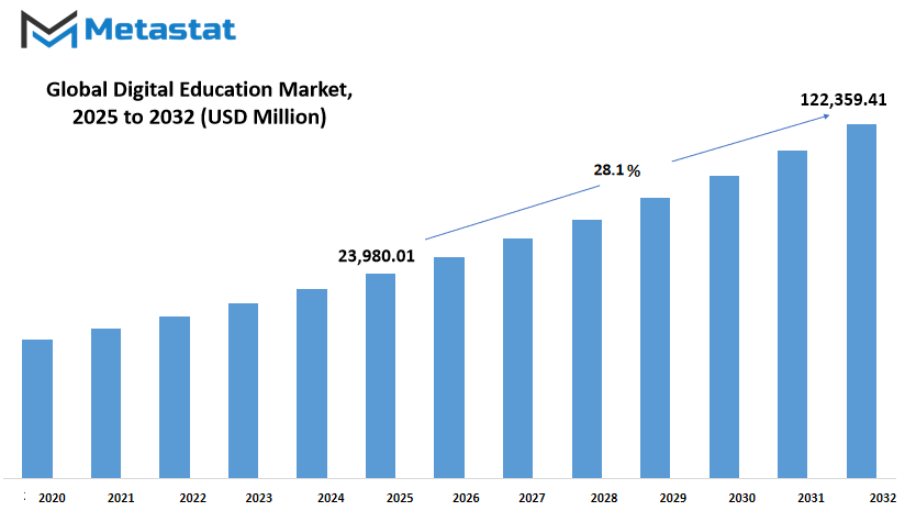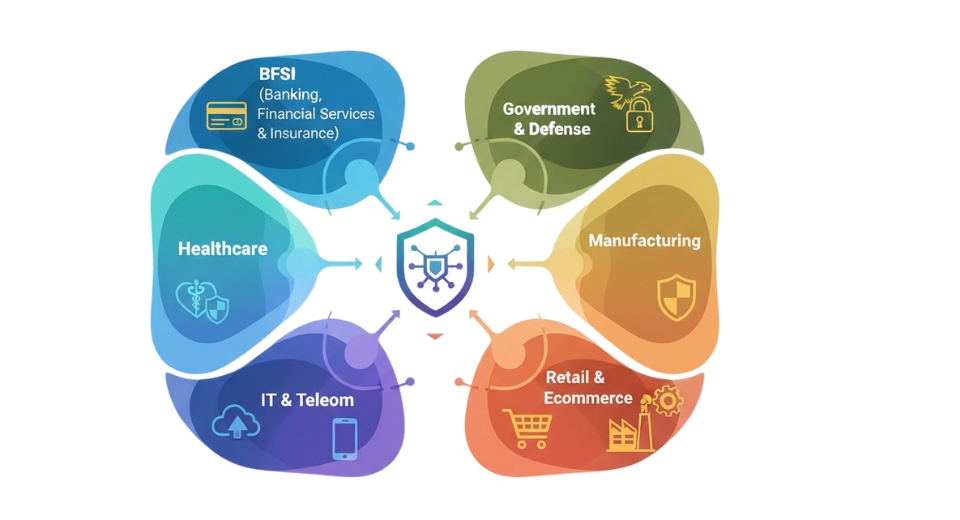MARKET OVERVIEW
The global digital education market will continue to redefine the way knowledge is disseminated, consumed, and reinterpreted in various cultures and economies. With technology extending into every sphere of life, learning will cease to be confined by the conventional classroom or the constraints of physical infrastructure. The shift towards digital learning will not merely supplant current systems; rather, it will reshape the paradigm for the approach to teaching and learning in the next decades. Central to this change is increasing recognition that learning can be done anywhere, any time, with equipment unimaginable in the traditional model of education.
The global digital education market will extend further than the provision of online classes. It will produce experiences that engage actively, not passively receive information. Students and teachers and organizations will engage each other in a manner that will be less transactional and more collaborative, with the supports of platforms that will enable fluid communication and creative problem-solving. Its growth will not simply be about digitizing textbooks. It will entail the building of new ecosystems in which students will find personalized paths molded by their unique pace and preferences.
The capacity to personalize content and adjust instruction will render education more flexible and responsive to individual human needs. For instance, students in distant corners of the globe who once had hurdles to getting access to quality learning will be linked to world resources that will enable them in ways that once seemed out of reach. The global market will also test the traditional notion of academic achievement. Rather than gauging learning through strict exams or standardized testing in isolation, new digital systems will give us more comprehensive measures. They will monitor not just what is recalled, but how knowledge is executed. This change will set up a system where abilities like creativity, problem-solving, and critical thinking will be as valuable as memorized facts. It is what will differentiate the digital education sector is its potential to fill gaps that have existed across generations. Institutions will no longer remain limited to only catering to those located within a specific geographic radius. Rather, the global market will establish networks through which experience, cultural views, and pedagogy will cross borders.
The outcome will be a more interlinked learning community where knowledge will be shared and remolded on a continuous basis. In the future, the sector will be tasked with making sure that access to digital tools continues to be fair and inclusive. The task won't just be to provide state-of-the-art technology but to create platforms that continue to be affordable and accessible to heterogeneous communities. As this evolution occurs, the international market of digital education will become a pillar of social and economic growth, shaping the way societies are getting ready for the challenges of tomorrow.
Finally, education will cease to be regarded as a limited process that concludes when one obtains a diploma or degree. With the expansion of online platforms, it will become a life-long quest, facilitated by flexible frameworks that yield to the evolving needs of learners. This continuous path will determine the position of the global digital education market in molding the future of human potential.
Global digital education market is estimated to reach $122,359.41 Million by 2032; growing at a CAGR of 28.1% from 2025 to 2032.

GROWTH FACTORS
The global digital education market will continue to gain attention as technological progress reshapes how learning is delivered and accessed worldwide. Growing adoption of e-learning platforms and online courses will push the demand for flexible and accessible education. With more learners seeking personalized and convenient options, digital platforms will become central to everyday learning, offering a wide range of subjects and skills that can be accessed at any time. This increasing demand will also stimulate ongoing innovation in new web-based tools and materials, enabling education to reach groups that heretofore did not have access to quality instruction. Support from the government and institutions will also be crucial in opening up the global market.
Incentives to support digital learning will give increased support to schools, colleges, and training institutions in adopting online approaches in addition to the conventional ones. Technology funding, teacher education, and digital infrastructure will assist in making sustainable systems that aid long-term education objectives. With growing governments striving for inclusive and cheaper learning, digital education will be an essential tool in eliminating barriers and increasing access globally.
While this development is taking place, there are challenges that may hinder growth of the global market. The digital divide remains the biggest challenge, particularly in rural communities where limited internet connectivity limits the opportunities of students.
Unless there is a constant connection and cheap devices, vast segments of the population will be left out of digital learning's benefits. Furthermore, creating good digital content and establishing sophisticated infrastructure demands high costs, which can keep smaller institutions from implementing these solutions. These challenges highlight the necessity of more cooperation between governments, private firms, and international institutions to bridge gaps and ensure equitable opportunities.
Meanwhile, accelerated innovation will spawn promising prospects that can transform the global market in the years ahead. Blending artificial intelligence and virtual reality with education will provide immersive, interactive experiences beyond what conventional methods can provide. AI-based learning platforms will present tailored lessons according to personal progress, while VR will enable learners to participate in real-world simulations and experiential learning that reinforce comprehension.
These innovations will not only enhance learning in terms of engagement but also efficiency in equipping students and professionals for real-world applications. Overall, the global digital education market will keep on growing as there is increasing demand for affordable and innovative learning. Although obstacles in the form of the digital divide and exorbitant prices must be overcome, accomodating policies and accelerated technological development will open new prospects. In the years ahead, digital education will transform itself into an integral component of global education systems, providing opportunities that are wider and more dynamic than ever before.
MARKET SEGMENTATION
By Revenue Model
The global digital education market is moving toward a future shaped by rapid technological growth and changing expectations from learners and organizations. With more people gaining access to the internet and devices, digital education has become an essential part of how knowledge is shared and consumed. In the coming years, this market will be defined not only by growth in size but also by diversity in revenue models that aim to meet different needs and budgets. Educational platforms and institutions are no longer restricted to a single method of reaching students; instead, they are adopting flexible strategies that allow learning to fit into daily life.
One of the most important parts of this growth is the expansion of subscription-based models. Many users prefer to pay a regular fee for unlimited access to a wide range of courses and learning tools. This approach provides a sense of stability for providers while ensuring continuous engagement from learners. Over time, subscription services are expected to introduce more personalized features, such as adaptive learning paths and real-time progress tracking, making the experience more engaging and efficient.
The Pay-Per-Course model will continue to attract learners who want specific skills without a long-term commitment. This model supports focused education, where individuals can select exactly what they need at the moment. It is especially appealing for professionals aiming to upgrade their skills or switch careers. In the future, this model may expand with micro-credentials and certifications that carry value in the workplace.
Freemium and Ad-supported models will also hold a strong place in the global market. Free content supported by optional paid upgrades ensures that education remains accessible to a wide audience, including those in regions with limited resources. Advertisements provide a source of revenue while allowing users to explore basic learning opportunities at no cost. With advances in technology, ad-targeting may become smarter, making the experience less disruptive and more useful.
Corporate licensing will play a critical role in the future of digital education as companies seek to keep their workforce skilled in line with industry demands. By investing in large-scale licensing agreements, organizations will be able to provide employees with structured and updated learning opportunities. This model benefits both employers and employees, creating a culture of continuous growth.
The global digital education market will continue to expand with these revenue models driving flexibility and inclusivity. Each approach offers unique benefits, and together they will create a balanced ecosystem that supports learners of all backgrounds while ensuring providers remain sustainable in a digital-first world.
By Technology
The global digital education market will continue to transform the way knowledge is shared, accessed, and applied. Rapid adoption of technology will allow education to move beyond the traditional classroom and reach a wider audience across different regions. With the growth of internet connectivity and smart devices, digital platforms will provide opportunities for flexible and personalized learning that will shape future generations. Continuous investment in innovation will support this expansion, creating an environment where learners and educators can interact in more dynamic and engaging ways.
By technology, the global digital education market will be divided into Learning Management Systems (LMS), Mobile Learning Apps, Virtual and Augmented Reality (XR), Artificial Intelligence and Adaptive Learning, and other solutions. Learning Management Systems will remain an essential foundation, offering organized platforms where institutions can create, deliver, and manage educational content efficiently. These systems will also help track progress, provide feedback, and ensure structured learning experiences. Mobile Learning Apps will drive accessibility, as they will enable learners to study anytime and anywhere, making education more inclusive for people with varying schedules and lifestyles.
Virtual and Augmented Reality will play a major role in reshaping the global market, as immersive experiences will allow learners to explore subjects in ways that go beyond textbooks. Virtual labs, simulated environments, and interactive lessons will make complex topics easier to understand, while also building stronger engagement. Artificial Intelligence and Adaptive Learning will further expand possibilities by creating personalized learning paths based on performance and individual needs. These technologies will not only save time but will also make education more efficient by identifying areas that require improvement and offering suitable resources. Other solutions, including cloud-based collaboration tools and online assessment systems, will complement these technologies, ensuring smooth integration across educational environments.
The future of the global market will also depend on how effectively governments, institutions, and private companies invest in digital infrastructure. As demand continues to grow, affordability and accessibility will remain key factors. Partnerships between technology providers and educational institutions will encourage innovation and ensure that learners benefit from advanced tools without barriers. In addition, the rise of data-driven decision-making will allow educators to analyze performance trends and develop teaching strategies that respond to changing needs.
Looking ahead, the global digital education market will not only expand in size but also in influence. With technology constantly advancing, education will become more interactive, personalized, and widely available. This growth will create a future where learning opportunities will be more flexible, inclusive, and adaptive to the challenges of a rapidly changing world.
By Revenue Model
The global digital education market is moving forward with strong growth and promises to reshape how learning will be accessed and delivered in the future. As technology continues to influence almost every sector, education is undergoing a transformation that will open up opportunities for learners and institutions alike. The shift toward digital platforms is not simply about replacing traditional classrooms with online lessons, but about creating flexible, scalable, and personalized systems that will meet the needs of different learners across the world.
By revenue model, the global digital education market is further divided into subscription-based, pay-per-course, freemium and ad-supported, and corporate licensing. Each of these models will play an important role in shaping the accessibility and sustainability of digital education. The subscription-based approach will provide learners with continuous access to a wide range of courses and resources at a fixed cost, making it attractive for those who prefer long-term engagement. This model will also allow providers to maintain a steady stream of revenue, which will help in improving content quality and platform features.
The pay-per-course model will remain useful for individuals seeking specific skills without the need for ongoing commitment. This approach will attract working professionals who want to upgrade their knowledge in targeted areas and are willing to invest only in what is required at the moment. On the other hand, the freemium and ad-supported structure will lower entry barriers, allowing users to experience learning content for free while premium features remain available at a cost. This system will expand reach to learners in developing regions and will help build large user bases that can be monetized later through advanced offerings.
Corporate licensing will play a key role in professional development and workforce training. Companies will increasingly invest in digital education platforms to upskill employees and ensure adaptability to rapid technological changes. This model will encourage partnerships between businesses and education providers, creating tailored content that meets industry demands.
Looking ahead, the global market will benefit from advancements in artificial intelligence, data analytics, and interactive learning tools that will make education more adaptive and engaging. Accessibility will continue to improve as internet penetration expands, ensuring that learners from remote and underserved areas will also have opportunities to grow. The blending of flexible revenue models will ensure that affordability, quality, and innovation remain balanced. With growing recognition of lifelong learning, the global digital education market will stand as a foundation for continuous knowledge development across generations, preparing societies for challenges and opportunities in the years to come.
By End-user
The global digital education market is moving toward a future where access to knowledge will no longer be limited by physical classrooms or geographic boundaries. Rapid advancements in technology, growing internet penetration, and the demand for flexible learning methods will continue to shape how education is delivered and experienced. Digital platforms are providing opportunities for learners of all ages to engage in personalized learning, while also allowing educators to expand reach beyond traditional settings. This trend will drive further growth as both developing and developed regions seek solutions that are cost-effective, scalable, and adaptable.
By end-user, the global digital education market will be divided into Academic Institutions and Individuals, Enterprise, Government and Non-profits, and Vocational Training Centres. Academic Institutions and Individuals will form a significant portion of this market, as schools and universities adopt hybrid and fully online models. Digital tools will support blended classrooms, allowing educators to use interactive technologies while students benefit from self-paced study. Individuals will also rely on digital courses to enhance skills, learn new topics, or prepare for examinations, making this segment a strong driver of adoption.
The Enterprise sector will continue to use digital education for employee training and development. Companies will prefer digital platforms because they reduce costs, save time, and provide real-time tracking of employee progress. Customized programs will also ensure that workers acquire job-specific skills quickly. As industries face constant changes in technology, enterprises will increasingly turn to digital learning to keep their workforce competitive.
Government and Non-profits will play a major role in promoting access to education through digital platforms. Programs focused on digital literacy, workforce development, and public awareness will expand with support from these organizations. Governments will use digital education to reduce inequality in access, especially in remote or underserved regions. Non-profits will also provide low-cost or free educational resources, ensuring that more communities benefit from the opportunities offered by digital platforms.
Vocational Training Centres will rely heavily on digital methods to prepare learners for specialized jobs. Training programs for fields such as healthcare, technology, and skilled trades will benefit from simulations, interactive modules, and virtual classrooms. These centres will help bridge the gap between education and employment by providing practical and market-driven training.
The future of the global digital education market will be marked by innovation, inclusivity, and accessibility. With continuous improvements in artificial intelligence, cloud solutions, and interactive technologies, education will become more engaging, efficient, and widely available. This transformation will redefine how knowledge is gained, shared, and applied in everyday life.
|
Forecast Period |
2025-2032 |
|
Market Size in 2025 |
$23,980.01 million |
|
Market Size by 2032 |
$122,359.41 Million |
|
Growth Rate from 2025 to 2032 |
28.1% |
|
Base Year |
2024 |
|
Regions Covered |
North America, Europe, Asia-Pacific Green, South America, Middle East & Africa |
REGIONAL ANALYSIS
The global digital education market is expected to play a central role in shaping how learning systems will transform in the coming years. Technology has already redefined the approach to education, making it more flexible, accessible, and adaptable to the needs of different learners. As digital platforms continue to expand, the demand for more personalized, interactive, and skill-focused learning experiences will increase. This shift is not limited to one area but extends across various regions, where each brings unique challenges and opportunities for growth.
Based on geography, the global market is divided into North America, Europe, Asia-Pacific, South America, and the Middle East & Africa. North America is further segmented into the U.S., Canada, and Mexico. This region will likely continue to lead adoption because of advanced technological infrastructure and early investment in educational software and platforms. Europe, which includes the UK, Germany, France, Italy, and the Rest of Europe, will strengthen growth by focusing on collaborative learning solutions and cross-border digital initiatives that support diverse language and cultural needs. Asia-Pacific, divided into India, China, Japan, South Korea, and the Rest of Asia-Pacific, will emerge as one of the fastest-growing regions due to rising internet penetration, a young population eager for upskilling, and government-led projects that promote online learning.
South America, which includes Brazil, Argentina, and the Rest of South America, will see digital learning expanding as connectivity improves and more institutions adopt remote and hybrid education models. The Middle East & Africa, categorized into GCC Countries, Egypt, South Africa, and the Rest of Middle East & Africa, will benefit from increasing investments in education technology, supported by national policies aimed at improving access to quality education for both urban and rural populations.
Looking ahead, the global digital education market will focus on integrating artificial intelligence, virtual reality, and adaptive learning methods to create a more immersive and effective experience. The future will not only emphasize academic content but also practical skills that match the needs of a changing job landscape. As digital tools continue to grow more sophisticated, learners in different regions will gain better opportunities to participate in global knowledge exchange without physical barriers. The combination of improved infrastructure, government support, and innovation will ensure that digital education becomes a permanent and expanding part of the global education system.

COMPETITIVE PLAYERS
The global digital education market is growing rapidly as technology continues to change the way knowledge is delivered and consumed. Learning is no longer limited to physical classrooms or traditional methods, but is instead shifting toward online platforms that provide flexibility, accessibility, and scalability. This transformation will continue to expand in the years ahead, supported by strong demand from students, professionals, and organizations looking for efficient ways to build skills. With increased internet penetration, affordable devices, and rising demand for lifelong learning, the global market will remain a central force shaping how education is designed and experienced.
Competition in this space is already intense, with several leading companies setting benchmarks and building innovative models. Coursera, Inc has built strong partnerships with universities across the world, giving learners access to academic-level programs online. 2U, Inc has followed a similar approach by offering degree programs in collaboration with established institutions. Platforms like Udemy, Inc and BYJU’S have targeted both professionals and students with wide-ranging courses that cater to different needs, while Udacity, Inc has specialized in technology-focused programs to prepare learners for future jobs. Khan Academy, Inc remains a key player with its focus on free access to high-quality resources, while FutureLearn Limited continues to grow its presence in global markets with university-backed courses.
Other important competitors include Pluralsight, Inc, which is well known for technology training, and edX LLC, which has been integrated with leading universities and organizations to deliver professional certificates and degree programs. Chegg, Inc has built a reputation in academic support and study materials, while Simplilearn Inc. has placed strong focus on certification and professional training. Codecademy, now part of Skillsoft Corp, has become a popular platform for coding education, and Alison has established itself as an open-access provider for learners worldwide. Platforms like OpenSesame Inc, Moodle Pty Ltd, Anthology Inc., Docebo Inc, Litmos US, L.P., and Instructure Inc are also strengthening their roles by focusing on corporate training, learning management systems, and scalable solutions.
The future of the global market will be shaped by these competitive players, each seeking to secure larger market share by offering unique experiences, advanced technology integration, and content tailored to individual learning goals. Artificial intelligence, adaptive learning tools, and immersive technologies such as virtual and augmented reality will further define the growth path. With such advancements, the global digital education market will not only expand its reach but also transform how knowledge is gained, shared, and applied in professional and academic life.
Digital Education Market Key Segments:
By Revenue Model
- Subscription-based
- Pay-Per-Course
- Freemium and Ad-supported
- Corporate Licensing
By Technology
- Learning Management Systems (LMS)
- Mobile Learning Apps
- Virtual and Augmented Reality (XR)
- Artificial Intelligence and Adaptive Learning
- Others
By Revenue Model
- Subscription-based
- Pay-Per-Course
- Freemium and Ad-supported
- Corporate Licensing
By End-user
- Academic Institutions and Individuals
- Enterprise
- Government and Non-profits
- Vocational Training Centres
Key Global Digital Education Industry Players
- Coursera, Inc
- 2U, Inc
- Udemy, Inc
- BYJU’S
- Udacity, Inc
- Khan Academy, Inc
- FutureLearn Limited
- Pluralsight, Inc
- edX LLC
- Chegg, Inc
- Simplilearn Inc.
- Codecademy (Skillsoft Corp)
- Alison
- OpenSesame Inc
- Moodle Pty Ltd
WHAT REPORT PROVIDES
- Full in-depth analysis of the parent Industry
- Important changes in market and its dynamics
- Segmentation details of the market
- Former, on-going, and projected market analysis in terms of volume and value
- Assessment of niche industry developments
- Market share analysis
- Key strategies of major players
- Emerging segments and regional growth potential








 US: +1 3023308252
US: +1 3023308252






